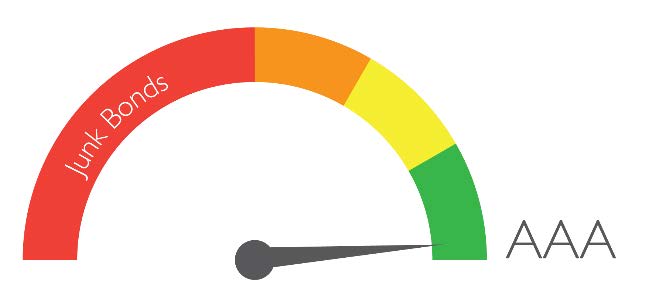Bond Ratings
What is Ottawa County's bond rating?
Ottawa County, Michigan's bond rating was reaffirmed in January 2024 and remains AAA from Moody's Investors Service. This highest possible rating signifies Ottawa County's exceptional financial management, strong economy, diverse tax base, and low debt burden. In fact, the debt carried by Ottawa is only 7.5% of its allowed limit. The County's prudent fiscal policies, fund balance and robust economic growth driven by a diverse mix of industries have contributed to its stellar creditworthiness. Additionally, Ottawa County's stable governance practices and proactive approach to budget management have instilled confidence in investors, resulting in favorable borrowing terms.

What is a bond rating?
A county bond rating is an assessment of creditworthiness. Credit rating agencies, such as Moody's Investors Service, Standard & Poor's, and Fitch Ratings, assign these ratings. These agencies objectively examine factors such as a county's financial health, economic stability, debt levels, budget management, governance practices, and historical repayment track record. They evaluate a county's ability to generate revenue, manage expenses, and repay debt obligations. Factors like population growth, employment trends, tax base diversity, and demographic characteristics also play a role.
The bond rating indicates the level of risk associated with investing in a county's bonds. Ratings typically range from AAA (highest quality and lowest risk) to D (default), with intermediate grades such as AA, A, BBB, etc., representing varying degrees of credit risk. A higher bond rating indicates lower risk and typically results in lower borrowing costs for a county. Borrowing is important for infrastructure improvements, like new police stations, courthouses, or utility investments.
Why are bond ratings important?
- Cost of Borrowing: Higher bond ratings typically result in lower borrowing costs for counties when they embark on a capital project, like a new building. A strong credit rating allows counties to issue bonds at lower interest rates, saving taxpayer money on debt service payments.
- Investor Confidence: Bond ratings provide investors with an objective assessment of a county's creditworthiness. Higher ratings indicate lower risk, which attracts a broader pool of investors willing to purchase county bonds. This increased demand can further drive down borrowing costs.
- Access to Capital: Counties rely on bond markets to finance essential infrastructure projects, such as courthouses, bridges, or utilities. A favorable bond rating ensures access to capital markets and facilitates the timely execution of projects critical for community development and growth.
- Financial Management: Maintaining a strong bond rating requires sound financial management practices, including prudent budgeting, debt management, and fiscal responsibility. Bond ratings serve as a measure of a county's financial health and governance effectiveness.
- Economic Development: Counties with higher bond ratings often enjoy greater economic stability and are more attractive to businesses and investors. A positive credit rating can signal a stable and favorable environment for economic development, leading to increased investment, job creation, and growth opportunities.
- Reputation and Image: Bond ratings reflect a county's reputation and credibility in the financial markets. A downgrade in bond ratings can tarnish a county's image, signaling financial distress and potentially affecting its ability to attract investors and secure favorable terms in the future.
What factors could lead to a decrease in a county's bond rating?
It is easy to assume that politics and elections can impact county bond ratings, but this is rarely true. County government bond ratings are based on objective financial criteria rather than political affiliation. Factors influencing bod ratings include:
- Economic Downturn: A significant economic downturn could impact a county's revenue streams, such as property taxes, leading to financial strain and potential difficulty in meeting debt obligations.
- Increased Debt Levels: A substantial increase in debt levels, either through issuing additional bonds, could raise concerns about a county's ability to manage its debt burden and repay existing obligations.
- Decline in Financial Reserves: A depletion of financial reserves or liquidity could indicate a weakening financial position and reduce a county's ability to withstand unforeseen challenges or emergencies.
- Governance Issues: Any governance issues, such as political instability, corruption, or ineffective decision-making, could undermine investor confidence and lead to a downgrade in a bond rating.
- Population Decline or Demographic Shifts: Significant population decline or unfavorable demographic shifts could impact a county's tax base, affecting its revenue generation capacity and long-term economic outlook.
- Legal or Regulatory Challenges: Legal or regulatory challenges, such as lawsuits or changes in state laws affecting local finances, could create uncertainties and increase risk for bondholders.
- Infrastructure or Capital Needs: Failure to adequately address infrastructure needs or deferred maintenance could raise concerns about the county's ability to maintain essential services and infrastructure, impacting its creditworthiness.
- Environmental or Natural Disaster Risks: Environmental risks or exposure to natural disasters, such as flooding or severe weather events, could pose financial liabilities and increase a county's risk profile.
When are bond ratings reviewed?
County bond ratings are most often reassessed in advance of upcoming bond issuances or refinancing activities. Credit rating agencies may also review county bond ratings in response to changes in economic conditions, fiscal policies, or significant events that could impact a county's financial health. Reassessments are based on objective financial criteria.
